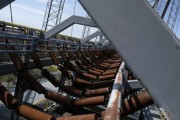**Title: Exploring the Innovation: New Energy Fire Trucks in Zhumadian**
**Introduction**
In recent years, the integration of new energy technology in various industries has sparked innovation and sustainability. The deployment of new energy vehicles, including fire trucks, showcases a commitment to reducing carbon footprint while enhancing operational efficiency. This article delves into the concept of new energy fire trucks, particularly in Zhumadian, exploring their benefits, functionalities, and future prospects.
**Understanding New Energy Fire Trucks**
New energy fire trucks represent a paradigm shift in firefighting technology, leveraging alternative energy sources such as electricity, hydrogen fuel cells, or hybrid systems instead of traditional fossil fuels. These trucks are designed to provide efficient firefighting capabilities while significantly reducing emissions and environmental impact.
**Features and Functionalities**
1. **Alternative Power Sources:** Unlike conventional fire trucks reliant on diesel or gasoline, new energy fire trucks integrate electric motors, hydrogen fuel cells, or hybrid systems. Electric-powered fire trucks utilize rechargeable batteries, offering quiet operation and zero tailpipe emissions. Hydrogen fuel cell trucks generate electricity through a chemical reaction between hydrogen and oxygen, emitting only water vapor. Hybrid models combine multiple power sources for enhanced flexibility and range.
2. **Advanced Safety Systems:** New energy fire trucks are equipped with cutting-edge safety features to ensure optimal performance during emergencies. These may include advanced fire suppression systems, thermal imaging cameras, and real-time monitoring capabilities. Additionally, built-in telemetry systems enable remote diagnostics and predictive maintenance, enhancing reliability and uptime.
3. **Customized Configurations:** Manufacturers offer customizable configurations to suit the specific requirements of firefighting departments. This includes varying tank capacities, pump capacities, hose lengths, and compartment layouts. Modular designs allow for future upgrades and adaptations to emerging technologies.
**Benefits of New Energy Fire Trucks**
1. **Environmental Sustainability:** By transitioning to new energy fire trucks, municipalities like Zhumadian can significantly reduce greenhouse gas emissions and air pollution associated with traditional firefighting vehicles. This aligns with global efforts to combat climate change and improve air quality.
2. **Cost Savings:** While the initial purchase cost of new energy fire trucks may be higher than conventional counterparts, long-term savings are realized through lower fuel and maintenance expenses. Electric vehicles benefit from lower electricity prices compared to gasoline or diesel, while hydrogen fuel cell systems become more cost-effective with advancements in technology and infrastructure.
3. **Operational Efficiency:** New energy fire trucks offer quieter operation and smoother acceleration compared to diesel engines, enhancing driver comfort and maneuverability. Instant torque delivery from electric motors enables rapid response times during emergencies, improving overall firefighting effectiveness.
**Challenges and Considerations**
1. **Infrastructure Development:** The widespread adoption of new energy fire trucks necessitates the development of supporting infrastructure, including charging stations for electric vehicles and hydrogen refueling stations. Municipalities must invest in infrastructure expansion to facilitate the transition to alternative energy sources effectively.
2. **Training and Education:** Firefighters require specialized training to operate and maintain new energy fire trucks safely. Training programs should cover vehicle handling, charging procedures, and emergency protocols specific to alternative power sources. Continuous education ensures proficiency and confidence among firefighting personnel.
3. **Range Limitations:** Electric and hydrogen-powered fire trucks may experience range limitations compared to their diesel counterparts, particularly in areas with limited charging or refueling infrastructure. Manufacturers and municipalities must collaborate to optimize vehicle range and address potential range anxiety concerns.
**Future Outlook**
The future of new energy fire trucks in Zhumadian and beyond is promising, with ongoing advancements in technology and growing environmental consciousness driving adoption. As battery energy density improves and charging infrastructure expands, electric fire trucks will become more practical for widespread deployment. Similarly, advancements in hydrogen fuel cell technology and infrastructure will enhance the viability of hydrogen-powered fire trucks as a clean energy solution.
**Conclusion**
The introduction of new energy fire trucks represents a significant leap forward in firefighting technology, offering environmental sustainability, cost savings, and operational efficiency. Municipalities like Zhumadian play a crucial role in embracing these innovations, paving the way for a greener and more resilient future in firefighting operations. Through strategic investments, training initiatives, and collaborative partnerships, the transition to new energy fire trucks can be realized, ensuring safer communities and a healthier planet for generations to come.










